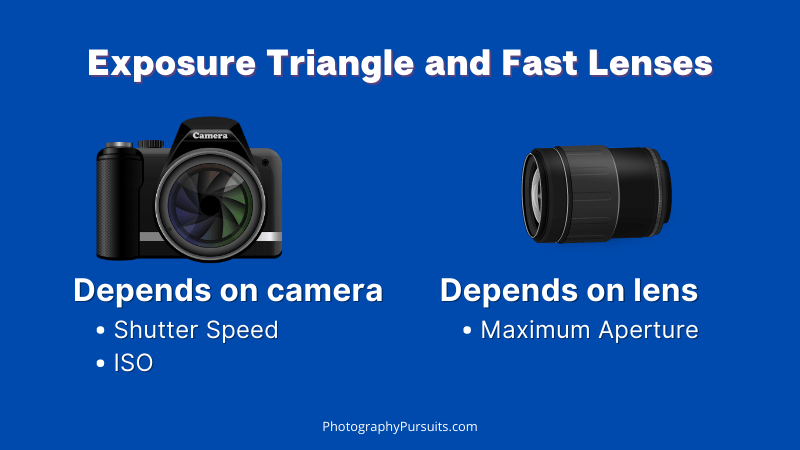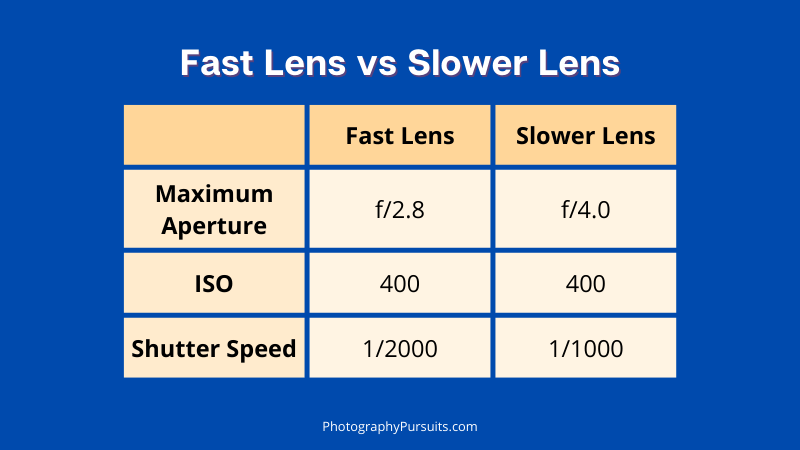So what the heck is a fast lens and what is a slow lens? And does lens ‘speed’ even make a difference?
Well yes, it does. It’s pretty important actually and that’s why people will spend a lot more on ‘fast’ lenses compared to ‘slower’ lenses.
Table of Contents
What Exactly Is A Fast Lens And What Is A Slow Lens?
In short, when people say a lens is ‘fast’ they mean that it can operate at faster shutter speeds for a given amount of light, because it has a wider aperture compared to other lenses.
For example, a f/2.8 lens is faster than a f/4 lens. In fact, at f/2.8 your lens lets in around twice the amount of light than at f/4. This means you can use a shutter speed that is twice as fast.
So a lens with a wider maximum aperture is considered faster than a lens with a smaller maximum aperture.
💡 Tip: If people are talking about ‘fast glass’ they basically mean a fast lens and if people are talking about ‘slow glass’ they are talking about a slow lens.
I’ll break this down further below to make it easier to understand with actual numbers.
Understanding Lens Speed With An Example
We know that there are 3 things in the exposure triangle that affect your exposure.
That’s ISO, shutter speed and aperture.
Out of these three things, only ISO and shutter speed is dependent on the camera.
The aperture however is dependent on the lens used.

You’ve probably heard this a million times before, but just in case you haven’t…
The aperture is the opening in the lens that controls the amount of light allowed through the lens and onto the image sensor.
A wider aperture means a larger opening or a low f/stop number (like f/2.0). On the other hand, a smaller aperture means a smaller opening or higher f/stop number (like f/11).
Let’s use an example to show you how a f/2.8 lens is faster than a f/4 lens.
Example of ‘fast’ f/2.8 vs ‘slower’ f/4 lens:
- ‘Fast’ lens has a maximum aperture of f/2.8
- ‘Slow’ lens has a maximum aperture of f/4
- We will use each lens at its maximum aperture
- We are going to use a constant ISO of 400 for both lenses
Let’s say our perfect exposure on the slow lens at f/4 with an ISO of 400 requires a shutter speed of 1/1000 seconds.
f/2.8 is one stop larger than f/4 and an aperture of f/2.8 actually allows twice as much light as an aperture of f/4. (I won’t go into detail about how this works as it’s not the point of this post.)
Just remember that f/2.8 is twice as much light as f/4.
Now remember that at f/4 our perfect exposure had a shutter speed of 1/1000 seconds.
Since our f/2.8 aperture on our faster lens lets in twice as much light, to have the same amount of light in our ‘perfect exposure’ we need a shutter speed that lets in half as much light (to balance for twice as much light due to the larger aperture).
So now we can actually use a shutter speed of 1/2000 seconds which is twice as fast.
Here’s what that looks like in a summary:
- Both lenses use ISO 400
- Fast lens at f/2.8 with shutter speed 1/2000 seconds
- Slow lens at f/4 with shutter speed of 1/1000 seconds
Here you can see the faster lens allows for a faster shutter speed. So when people are talking about ‘fast’ lenses the ‘fast’ bit is actually referring to the shutter speed you can use.

Let’s build on our example to show you how this can be important.
Imagine you are shooting in low light and you’re stuck at f/4 and you’ve already maxed out your ISO as far as you’re comfortable with.
You lower your shutter speed to make sure you can get enough light in the picture, but the shutter speed is just a tiny bit too slow.
Now you are getting blurry pictures because you have moving subjects, you’re not going to get paid because your lens is too slow, and you’re going to end up on the street (okay maybe not the last part).
Now in this scenario if you were able to make your aperture larger to f/2.8 or f/2.0 then you might be able to save your blurry pictures by allowing for a faster shutter speed.
This is why some people will pay a lot more for a faster lens because it can make the difference between getting usable pictures and getting paid, or not.
Examples Of Fast And Slow Lenses
Within the same focal length you can get faster and slower lenses and this normally also reflects the price of them because faster lenses are generally more expensive to produce.
For example, here are three different Canon EF 50mm lenses.
Just comparing the prices of these three lenses you can see just how important it can be to have a faster lens.
Of course the maximum aperture isn’t the ONLY thing that is affecting the price, but it’s a damn good indication.
Even within the same lens you can have focal lengths which are faster or slower if it is a zoom lens.
Take for example this Canon zoom lens:
You can see that it has an f-stop range of f/4-f/5.6. This means that its maximum aperture will change depending on the focal length used.
At the shorter end of focal lengths at 75mm, it will have a maximum aperture of f/4, but at the longer focal lengths at 300mm it will only have a maximum aperture of f/5.6.
Meaning that this lens will actually be faster at shorter focal lengths and slower at longer focal lengths.
When Do You Need A Fast Lens?
If you’re wondering if you would need a fast lens then the main things to consider are the two following questions:
- Are you going to be using your lens in low light conditions?
- Are you going to be photographing fast moving subjects?
In low-light conditions, you need all the help you can get to be able to use a fast enough shutter speed to avoid blurry pictures.
Having a fast lens in low-light conditions will give you more freedom to take pictures as you please.
If you are shooting fast moving subjects then you might have plenty of ambient light, but your shutter speed might have to be extremely fast to get that perfect action shot.
An example would be wildlife photography or sports photography.
Here’s a quick list of scenarios where a fast lens would be particularly useful:
- Night time concerts
- Indoor gigs
- Night photography
- Sports photography
- Wildlife photography
- Automotive photography
Summary
So…
Fast lens means faster shutter speed because of wider aperture.
Sometimes people will say ‘fast aperture’ which just means wide aperture which means low f-stop numbers like f/1.8, f/2.0 etc.
This is because fast aperture allows for faster shutter speeds.
If you want to watch a video to recap this post then the following video helped me understand this concept really quickly.
Related Reading:
If you are looking for Canon lenses for blurred backgrounds in your photos then fast lenses are actually perfect for these.
Did you know that apart from being a fast lens, another thing that can make a lens more expensive is having a wider angle focal length.
